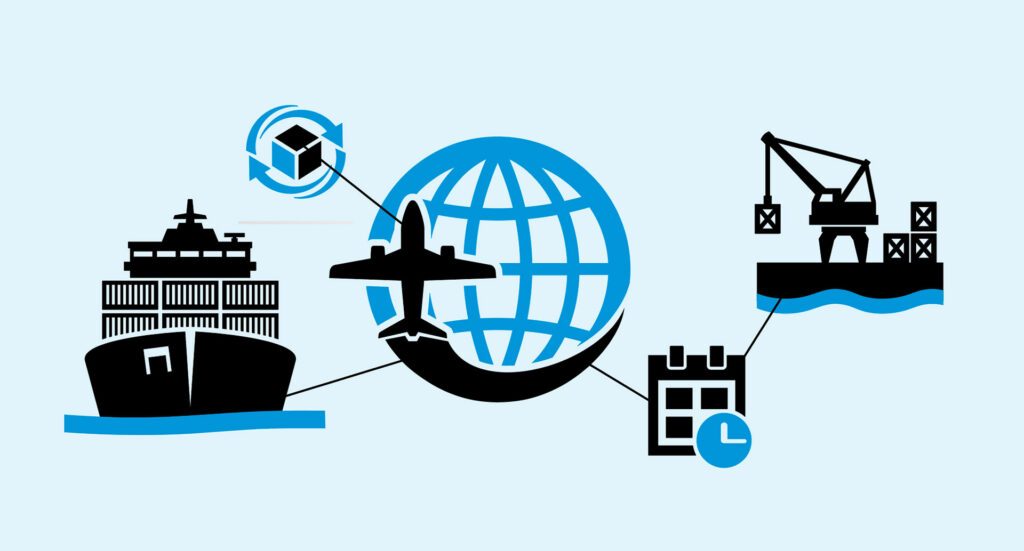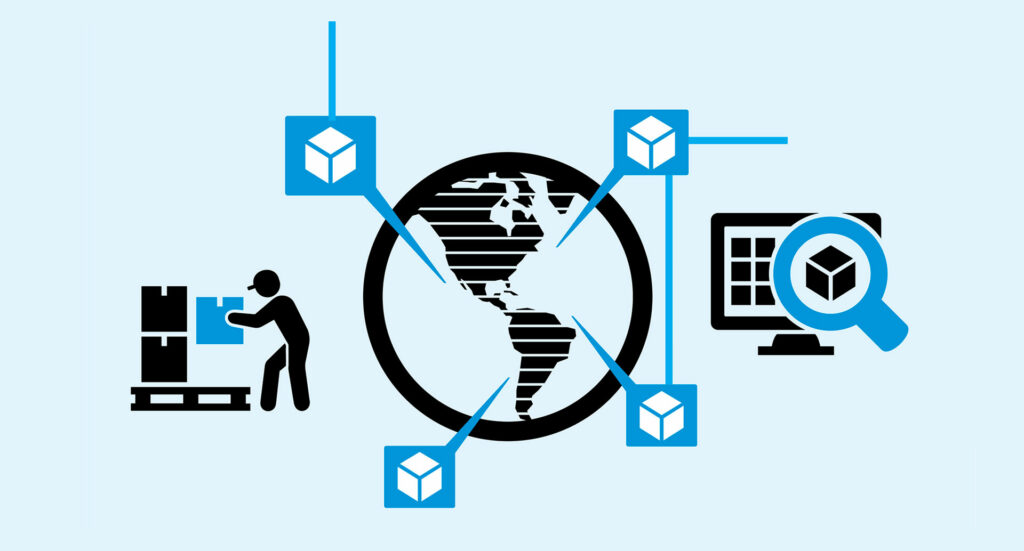Tech can’t prevent every freak incident, but, as HS2, Accenture and Boomi reveal, innovative software can help industries protect their supply chains during times of chaos.
“Something as small as the flutter of a butterfly’s wing can ultimately cause a typhoon halfway around the world.” This poetic phrase describing the butterfly effect is one we all know, perfectly describing a tenet of chaos theory on how one small change can have very large impacts further down the line.
A fluttering butterfly may have been behind the high winds and dust storm which saw one of the world’s largest container ships obstruct the Suez Canal last year. Carrying over 18,000 containers, the Ever Given was en route from Malaysia to Rotterdam when it ran aground for six days, blocking over two hundred vessels on the key supply chain route.
While much larger than a butterfly, the saga of the Ever Given served as a reminder of the many chains spanning our world, interconnecting assets between commerce and clients. After COVID, it also intensified the need for technology to augment the butterfly’s wings, as it were, in order to avoid further supply chain failings.
“Macro geopolitical events such as Ukraine and the Suez Canal crisis have led to supply chain shortfalls across the world,’’ says Dave Food, head of supply chain at Board International. “Consumers and businesses alike have been left frustrated by low inventories, delayed orders, and poor planning in asset heavy industries.
“These widespread problems have revealed outdated supply chain planning practices and tools that must be replaced immediately.”
As we discover, replacing those tools can mean alternatives from the new frontier of technology, mainly in the form of digital twins, artificial intelligence (AI) and the internet of things (IoT).
Powering up ports
While it’s unlikely enterprise tech could prevent another freak incident on the scale of the Ever Given mishap, there are already examples in ports around the world of software and hardware working to prevent supply chain shortfalls.
Safety solutions from Silicon Valley’s Quanergy can be found in ports within China, South Korea and beyond. The company, which went public this February, is a provider of AI-powered sensors in light detection and ranging (LiDAR). 2D and 3D imaging created by LiDAR point clouds can provide accurate measurements to ensure safer, more efficient operations in the machinery, people and vessel-heavy environment of ports.
Case studies for ports in Shanghai and Shandong, China and Korea show how LiDAR can galvanise port automation, along with protecting the supply chain. Quanergy points out LiDAR sensors have a longer range than cameras or radar, and unlike cameras, can work under any weather condition.
“LiDAR (also) provides much better accuracy over computer vision in many applications,” says Gerald Becker, Quanergy’s VP market development and alliances. “We have seen flow management applications in which LiDAR alone provided significantly higher accuracy compared to camera and computer vision alone. The latter is challenged in different environments with varying weather or lighting conditions.”
What that means is actionable intelligence from LiDAR sensors in real-time flow management software. The result is port management and operators can react instantly to imminent safety risks as containers are moved between ships, storage, and truck beds. Such data also allows ports to better understand traffic patterns in order to create the most efficient and safe flows for assets.
Ports can also benefit from digital transformation in the back office. Mike Kiersey, director of global technology EMEA at integration platform Boomi, points to recent work with world-leading port agency Inchcape Shipping Services.
“(With Boomi) Inchcape was able to connect and integrate a multitude of different technology products to improve port logistics and better track its entire supply chain around the world,” says Kiersey.
This was made possible by a single view for the agency of its data, simplifying the entire supply chain. More agile compliance also became possible, particularly from being able to view vessel sanctions before any ship arrives at the Hong Kong port.
“By automating and orchestrating the discovery, cataloguing, preparation and integration of data from different sources, these enterprise technologies enable businesses to create a ‘common’ data language that better supports long-term data governance and provides a full understanding of employees, customers, and products,” says the Boomi director.
“By going even further and extending the reach of this connectivity and integration to partners and suppliers as well, organisations can truly optimise and simplify their supply chains, achieving greater operational efficiency.”
To the power of two
Data is clearly a vital weapon in managing supply chains in real-time with agile responsiveness. But what about predicting problems coming down the line, or ensuring long-term replenishment of assets?
This is where digital twins come in; real-time representations of physical assets, systems or processes that can be built using mixed reality and IoT. Representing a new frontier in business information modelling, digital twins can be found in industries ranging across construction, energy, transport and more.
There exists a growing digital twin of High Speed 2 (HS2), a high-speed railway line under construction in the UK aiming to connect London, Birmingham, the East Midlands and North West England like never before.
Currently coming at a £98bn price tag, the endeavour is one of Europe’s biggest infrastructure projects. While full operation is expected as far off as 2040, HS2 staff will very soon be using virtual reality (VR) headsets to explore an identical 3D replica of the track in order to help fix issues before they become a detriment to the project and its supply chain.
As detailed as its physical counterpart, this digital twin of the HS2 – HSSquared, perhaps? – will be fed continual data from the many sensors being built into the physical railway track, along with bridges and overhead power lines.
As HS2 Ltd innovation manager Heather Donald tells ERP Today, there will also exist digital twins of stations on the line, beginning with the pivotal Old Oak Common superhub which is tentatively scheduled to open in 2026.
Also accessible by VR headsets, the Old Oak Common twin is currently being tested by select members of the public for its passenger flow management, as using a world-first combination of VR, eye-tracking and emotion-sensing technology.
“We’re also exploring future uses,” Donald reveals. “Now we’ve got the model, we’re looking at how you could use it to test for safety along with different HS2 teams to test it out. We’re also exploring how we could use it for other HS2 stations.”
The biggest thing is multiple stakeholders accessing the same models, all learning together from the same data – Heather Donald / HS2

An interesting caveat of High Speed 2’s twin innovation is that HS2 Ltd offers double contracts to clients: one contract for a digital twin and another for the real-world asset. This not only points to the growing business importance of the tech, but also a smart way to avoid tangled management by siloed stakeholders. Having a digital twin available at the foundational stages of a project can only help avoid supply chain problems from forming and compounding.
“I think it’s most efficient to create one model that you’re constantly adding to with more capabilities,” Donald adds. “The biggest thing is having multiple stakeholders accessing the same models, and that’s how you and your partners are learning together from the same data.”
In the view of Stephane Crosnier, UK supply chain and operations lead for Accenture, digital twins give enterprises greater structural visibility when it comes to supply chains.
“Technology enables two types of visibility: structural and dynamic. Structural visibility is like an X-ray which gives you a snapshot of your operations to help uncover vulnerabilities.
“With a digital twin of its supply chain, a company can use advanced analytics to simulate its supply chain’s performance and stress test for risks and vulnerabilities.”
Accenture recently worked with one major European automotive supplier to manufacture enough product to meet demand. The company’s supply chain was struggling due to the current microchip shortage, another ongoing blight in today’s post-COVID world.
Supply chain visibility provided by technology can have a major impact on operating and financial performance – Stephane Crosnier / Accenture

Working with the supplier, Accenture developed a digital twin to provide visibility into interdependencies and to identify the revenue streams and clients that relied on specific subcomponents.
Currently, the automotive supplier’s supply chain teams are working with Accenture on deploying a digital twin-enabled supply chain stress test. This test will look across the chain to further identify vulnerabilities and risk areas, plus also calculate time parameters for specific threats or disruptions.
From the results, Accenture argues, a groundwork can be laid by the enterprise for subsequent actions it should take to prevent weak links in its supply chain.
“Ultimately, the supply chain visibility provided by technology can have a major impact on a company’s overall operating and financial performance,” says Crosnier.
“It’s an inescapable reality that the future of an organisation’s supply chain operations depends on more advanced big data and analytics capabilities – and those that don’t prioritise this risk falling behind their competitors.”
Technology can’t prevent every freak occurrence from happening, but it’s clear innovative software and hardware can help industries protect their supply chains in these chaotic times.




